Comprehensive Business Environment and TESCO Analysis Report
VerifiedAdded on 2020/12/09
|17
|4960
|223
Report
AI Summary
This report provides a comprehensive analysis of TESCO's business environment, examining various organizational types including public (NHS), private (TESCO), and voluntary (Save the Children) companies. It delves into their backgrounds, products, services, sizes, scopes, visions, missions, business objectives, and organizational and legal structures. The report also explores the interrelationships between different business functions within TESCO, such as marketing, human resource management, and finance, highlighting their advantages and disadvantages. Furthermore, it includes a PESTEL analysis to assess external macro-environmental factors and a SWOT analysis to identify the company's strengths, weaknesses, opportunities, and threats, providing a holistic view of TESCO's operational landscape and strategic positioning. The report emphasizes the importance of environmental analysis in business decision-making.
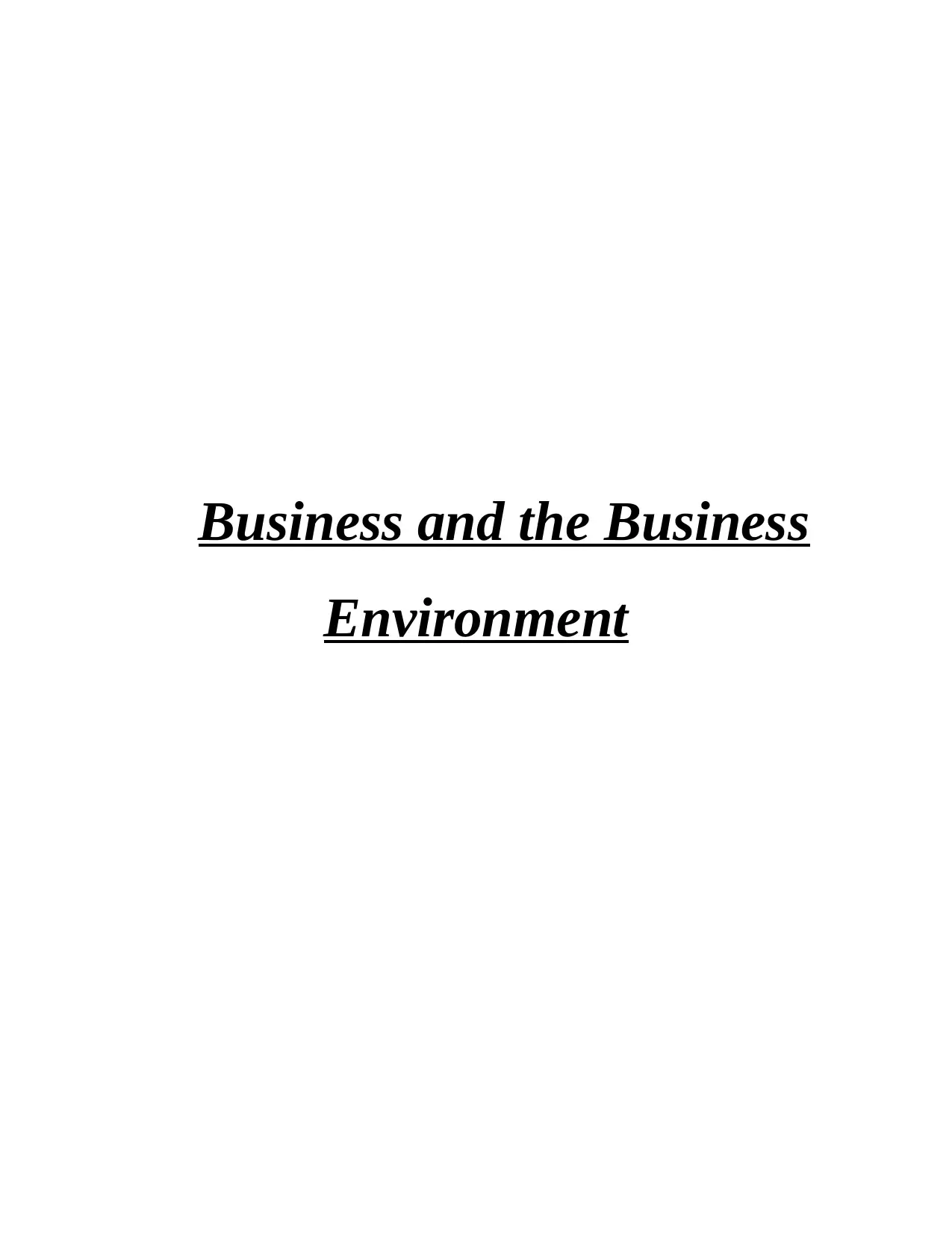
Business and the Business
Environment
Environment
Paraphrase This Document
Need a fresh take? Get an instant paraphrase of this document with our AI Paraphraser
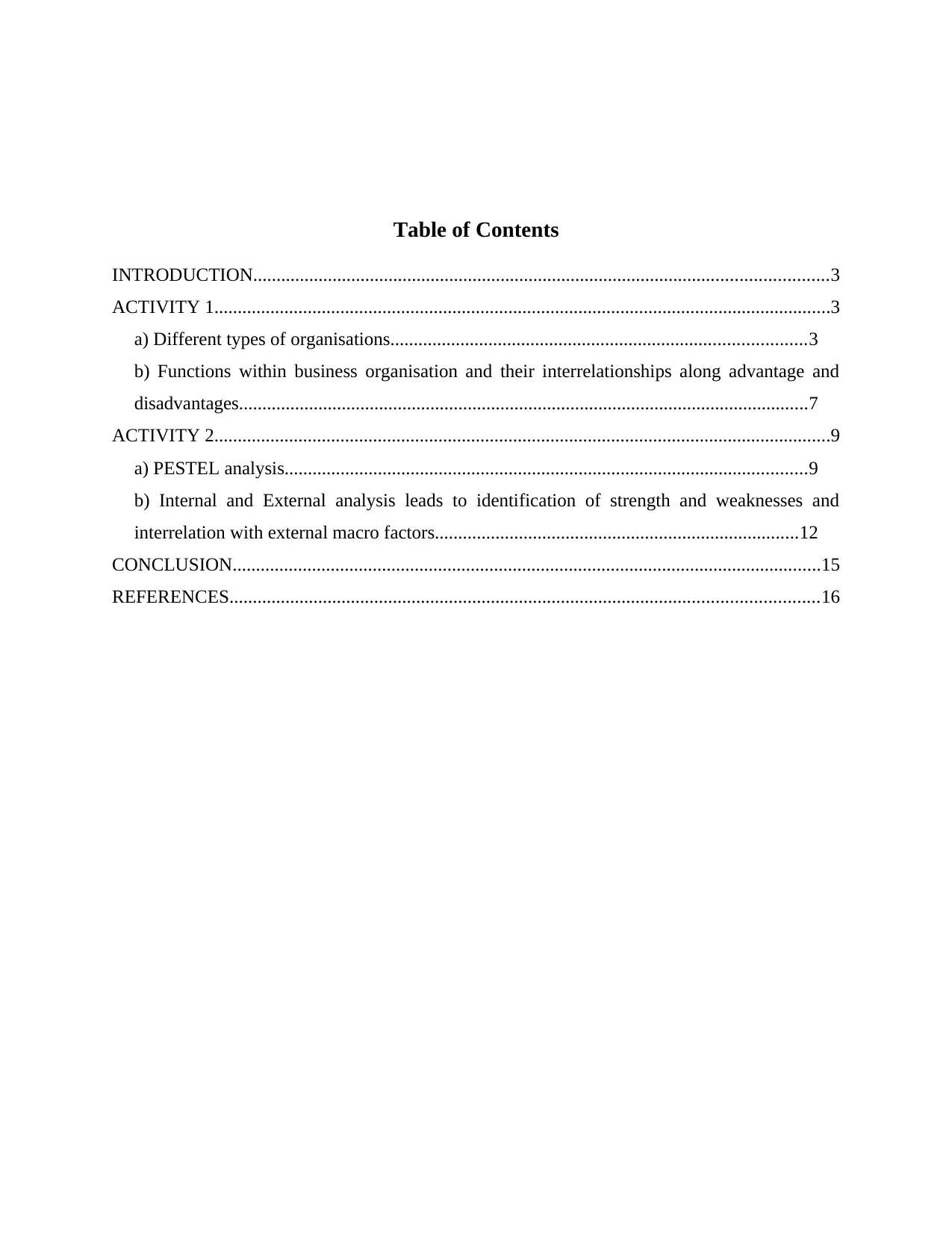
Table of Contents
INTRODUCTION...........................................................................................................................3
ACTIVITY 1....................................................................................................................................3
a) Different types of organisations.........................................................................................3
b) Functions within business organisation and their interrelationships along advantage and
disadvantages..........................................................................................................................7
ACTIVITY 2....................................................................................................................................9
a) PESTEL analysis................................................................................................................9
b) Internal and External analysis leads to identification of strength and weaknesses and
interrelation with external macro factors..............................................................................12
CONCLUSION..............................................................................................................................15
REFERENCES..............................................................................................................................16
INTRODUCTION...........................................................................................................................3
ACTIVITY 1....................................................................................................................................3
a) Different types of organisations.........................................................................................3
b) Functions within business organisation and their interrelationships along advantage and
disadvantages..........................................................................................................................7
ACTIVITY 2....................................................................................................................................9
a) PESTEL analysis................................................................................................................9
b) Internal and External analysis leads to identification of strength and weaknesses and
interrelation with external macro factors..............................................................................12
CONCLUSION..............................................................................................................................15
REFERENCES..............................................................................................................................16
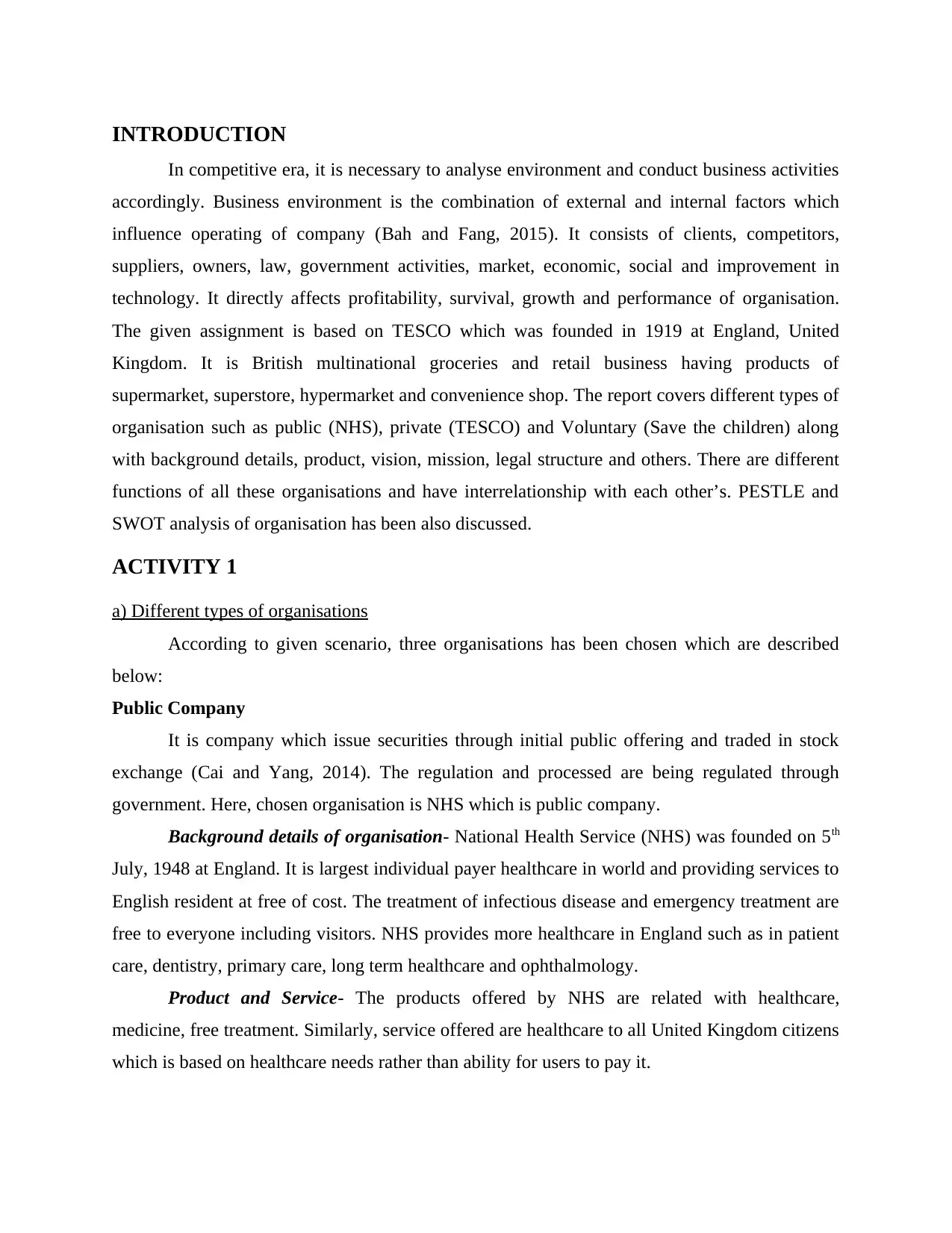
INTRODUCTION
In competitive era, it is necessary to analyse environment and conduct business activities
accordingly. Business environment is the combination of external and internal factors which
influence operating of company (Bah and Fang, 2015). It consists of clients, competitors,
suppliers, owners, law, government activities, market, economic, social and improvement in
technology. It directly affects profitability, survival, growth and performance of organisation.
The given assignment is based on TESCO which was founded in 1919 at England, United
Kingdom. It is British multinational groceries and retail business having products of
supermarket, superstore, hypermarket and convenience shop. The report covers different types of
organisation such as public (NHS), private (TESCO) and Voluntary (Save the children) along
with background details, product, vision, mission, legal structure and others. There are different
functions of all these organisations and have interrelationship with each other’s. PESTLE and
SWOT analysis of organisation has been also discussed.
ACTIVITY 1
a) Different types of organisations
According to given scenario, three organisations has been chosen which are described
below:
Public Company
It is company which issue securities through initial public offering and traded in stock
exchange (Cai and Yang, 2014). The regulation and processed are being regulated through
government. Here, chosen organisation is NHS which is public company.
Background details of organisation- National Health Service (NHS) was founded on 5th
July, 1948 at England. It is largest individual payer healthcare in world and providing services to
English resident at free of cost. The treatment of infectious disease and emergency treatment are
free to everyone including visitors. NHS provides more healthcare in England such as in patient
care, dentistry, primary care, long term healthcare and ophthalmology.
Product and Service- The products offered by NHS are related with healthcare,
medicine, free treatment. Similarly, service offered are healthcare to all United Kingdom citizens
which is based on healthcare needs rather than ability for users to pay it.
In competitive era, it is necessary to analyse environment and conduct business activities
accordingly. Business environment is the combination of external and internal factors which
influence operating of company (Bah and Fang, 2015). It consists of clients, competitors,
suppliers, owners, law, government activities, market, economic, social and improvement in
technology. It directly affects profitability, survival, growth and performance of organisation.
The given assignment is based on TESCO which was founded in 1919 at England, United
Kingdom. It is British multinational groceries and retail business having products of
supermarket, superstore, hypermarket and convenience shop. The report covers different types of
organisation such as public (NHS), private (TESCO) and Voluntary (Save the children) along
with background details, product, vision, mission, legal structure and others. There are different
functions of all these organisations and have interrelationship with each other’s. PESTLE and
SWOT analysis of organisation has been also discussed.
ACTIVITY 1
a) Different types of organisations
According to given scenario, three organisations has been chosen which are described
below:
Public Company
It is company which issue securities through initial public offering and traded in stock
exchange (Cai and Yang, 2014). The regulation and processed are being regulated through
government. Here, chosen organisation is NHS which is public company.
Background details of organisation- National Health Service (NHS) was founded on 5th
July, 1948 at England. It is largest individual payer healthcare in world and providing services to
English resident at free of cost. The treatment of infectious disease and emergency treatment are
free to everyone including visitors. NHS provides more healthcare in England such as in patient
care, dentistry, primary care, long term healthcare and ophthalmology.
Product and Service- The products offered by NHS are related with healthcare,
medicine, free treatment. Similarly, service offered are healthcare to all United Kingdom citizens
which is based on healthcare needs rather than ability for users to pay it.
⊘ This is a preview!⊘
Do you want full access?
Subscribe today to unlock all pages.

Trusted by 1+ million students worldwide
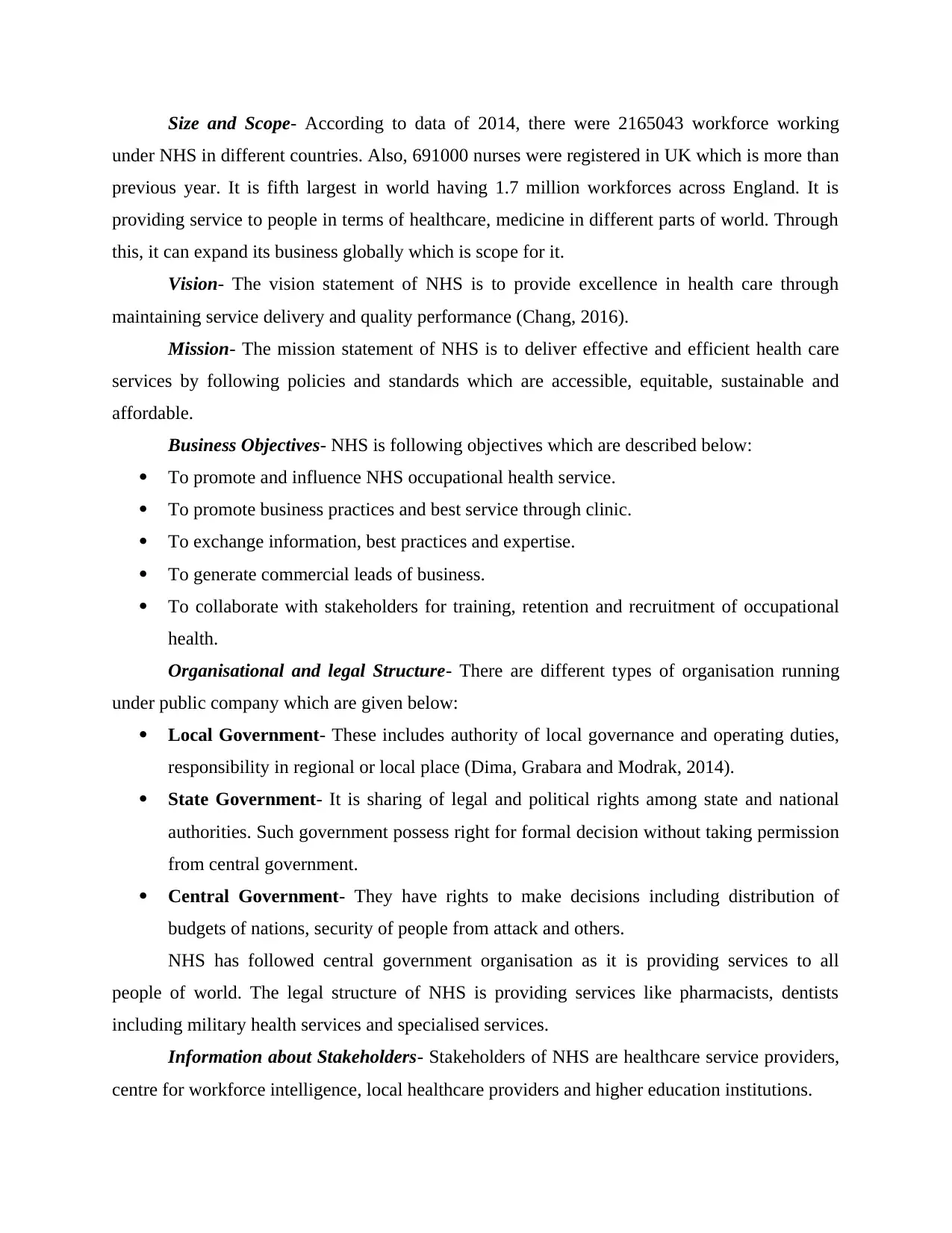
Size and Scope- According to data of 2014, there were 2165043 workforce working
under NHS in different countries. Also, 691000 nurses were registered in UK which is more than
previous year. It is fifth largest in world having 1.7 million workforces across England. It is
providing service to people in terms of healthcare, medicine in different parts of world. Through
this, it can expand its business globally which is scope for it.
Vision- The vision statement of NHS is to provide excellence in health care through
maintaining service delivery and quality performance (Chang, 2016).
Mission- The mission statement of NHS is to deliver effective and efficient health care
services by following policies and standards which are accessible, equitable, sustainable and
affordable.
Business Objectives- NHS is following objectives which are described below:
To promote and influence NHS occupational health service.
To promote business practices and best service through clinic.
To exchange information, best practices and expertise.
To generate commercial leads of business.
To collaborate with stakeholders for training, retention and recruitment of occupational
health.
Organisational and legal Structure- There are different types of organisation running
under public company which are given below:
Local Government- These includes authority of local governance and operating duties,
responsibility in regional or local place (Dima, Grabara and Modrak, 2014).
State Government- It is sharing of legal and political rights among state and national
authorities. Such government possess right for formal decision without taking permission
from central government.
Central Government- They have rights to make decisions including distribution of
budgets of nations, security of people from attack and others.
NHS has followed central government organisation as it is providing services to all
people of world. The legal structure of NHS is providing services like pharmacists, dentists
including military health services and specialised services.
Information about Stakeholders- Stakeholders of NHS are healthcare service providers,
centre for workforce intelligence, local healthcare providers and higher education institutions.
under NHS in different countries. Also, 691000 nurses were registered in UK which is more than
previous year. It is fifth largest in world having 1.7 million workforces across England. It is
providing service to people in terms of healthcare, medicine in different parts of world. Through
this, it can expand its business globally which is scope for it.
Vision- The vision statement of NHS is to provide excellence in health care through
maintaining service delivery and quality performance (Chang, 2016).
Mission- The mission statement of NHS is to deliver effective and efficient health care
services by following policies and standards which are accessible, equitable, sustainable and
affordable.
Business Objectives- NHS is following objectives which are described below:
To promote and influence NHS occupational health service.
To promote business practices and best service through clinic.
To exchange information, best practices and expertise.
To generate commercial leads of business.
To collaborate with stakeholders for training, retention and recruitment of occupational
health.
Organisational and legal Structure- There are different types of organisation running
under public company which are given below:
Local Government- These includes authority of local governance and operating duties,
responsibility in regional or local place (Dima, Grabara and Modrak, 2014).
State Government- It is sharing of legal and political rights among state and national
authorities. Such government possess right for formal decision without taking permission
from central government.
Central Government- They have rights to make decisions including distribution of
budgets of nations, security of people from attack and others.
NHS has followed central government organisation as it is providing services to all
people of world. The legal structure of NHS is providing services like pharmacists, dentists
including military health services and specialised services.
Information about Stakeholders- Stakeholders of NHS are healthcare service providers,
centre for workforce intelligence, local healthcare providers and higher education institutions.
Paraphrase This Document
Need a fresh take? Get an instant paraphrase of this document with our AI Paraphraser
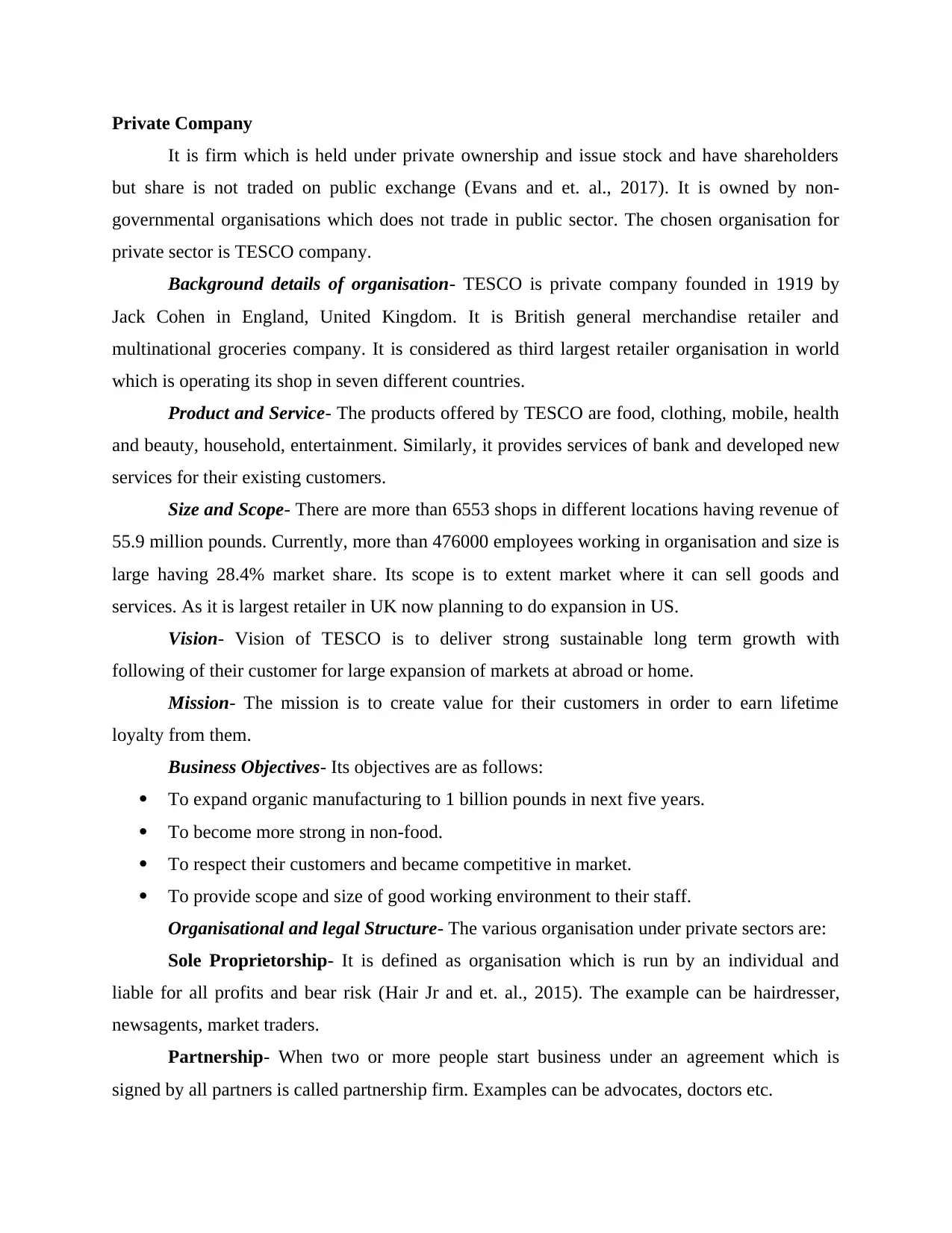
Private Company
It is firm which is held under private ownership and issue stock and have shareholders
but share is not traded on public exchange (Evans and et. al., 2017). It is owned by non-
governmental organisations which does not trade in public sector. The chosen organisation for
private sector is TESCO company.
Background details of organisation- TESCO is private company founded in 1919 by
Jack Cohen in England, United Kingdom. It is British general merchandise retailer and
multinational groceries company. It is considered as third largest retailer organisation in world
which is operating its shop in seven different countries.
Product and Service- The products offered by TESCO are food, clothing, mobile, health
and beauty, household, entertainment. Similarly, it provides services of bank and developed new
services for their existing customers.
Size and Scope- There are more than 6553 shops in different locations having revenue of
55.9 million pounds. Currently, more than 476000 employees working in organisation and size is
large having 28.4% market share. Its scope is to extent market where it can sell goods and
services. As it is largest retailer in UK now planning to do expansion in US.
Vision- Vision of TESCO is to deliver strong sustainable long term growth with
following of their customer for large expansion of markets at abroad or home.
Mission- The mission is to create value for their customers in order to earn lifetime
loyalty from them.
Business Objectives- Its objectives are as follows:
To expand organic manufacturing to 1 billion pounds in next five years.
To become more strong in non-food.
To respect their customers and became competitive in market.
To provide scope and size of good working environment to their staff.
Organisational and legal Structure- The various organisation under private sectors are:
Sole Proprietorship- It is defined as organisation which is run by an individual and
liable for all profits and bear risk (Hair Jr and et. al., 2015). The example can be hairdresser,
newsagents, market traders.
Partnership- When two or more people start business under an agreement which is
signed by all partners is called partnership firm. Examples can be advocates, doctors etc.
It is firm which is held under private ownership and issue stock and have shareholders
but share is not traded on public exchange (Evans and et. al., 2017). It is owned by non-
governmental organisations which does not trade in public sector. The chosen organisation for
private sector is TESCO company.
Background details of organisation- TESCO is private company founded in 1919 by
Jack Cohen in England, United Kingdom. It is British general merchandise retailer and
multinational groceries company. It is considered as third largest retailer organisation in world
which is operating its shop in seven different countries.
Product and Service- The products offered by TESCO are food, clothing, mobile, health
and beauty, household, entertainment. Similarly, it provides services of bank and developed new
services for their existing customers.
Size and Scope- There are more than 6553 shops in different locations having revenue of
55.9 million pounds. Currently, more than 476000 employees working in organisation and size is
large having 28.4% market share. Its scope is to extent market where it can sell goods and
services. As it is largest retailer in UK now planning to do expansion in US.
Vision- Vision of TESCO is to deliver strong sustainable long term growth with
following of their customer for large expansion of markets at abroad or home.
Mission- The mission is to create value for their customers in order to earn lifetime
loyalty from them.
Business Objectives- Its objectives are as follows:
To expand organic manufacturing to 1 billion pounds in next five years.
To become more strong in non-food.
To respect their customers and became competitive in market.
To provide scope and size of good working environment to their staff.
Organisational and legal Structure- The various organisation under private sectors are:
Sole Proprietorship- It is defined as organisation which is run by an individual and
liable for all profits and bear risk (Hair Jr and et. al., 2015). The example can be hairdresser,
newsagents, market traders.
Partnership- When two or more people start business under an agreement which is
signed by all partners is called partnership firm. Examples can be advocates, doctors etc.
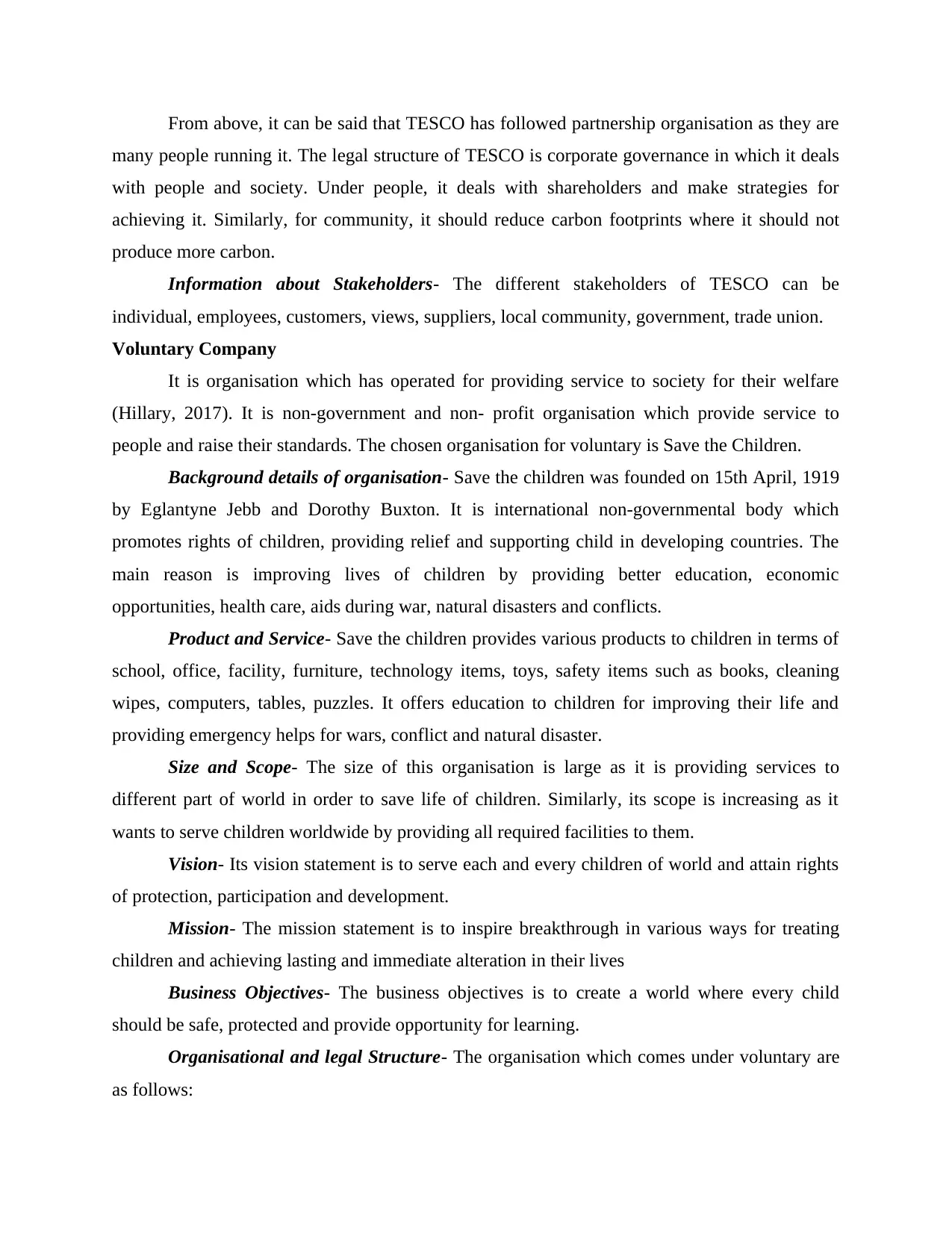
From above, it can be said that TESCO has followed partnership organisation as they are
many people running it. The legal structure of TESCO is corporate governance in which it deals
with people and society. Under people, it deals with shareholders and make strategies for
achieving it. Similarly, for community, it should reduce carbon footprints where it should not
produce more carbon.
Information about Stakeholders- The different stakeholders of TESCO can be
individual, employees, customers, views, suppliers, local community, government, trade union.
Voluntary Company
It is organisation which has operated for providing service to society for their welfare
(Hillary, 2017). It is non-government and non- profit organisation which provide service to
people and raise their standards. The chosen organisation for voluntary is Save the Children.
Background details of organisation- Save the children was founded on 15th April, 1919
by Eglantyne Jebb and Dorothy Buxton. It is international non-governmental body which
promotes rights of children, providing relief and supporting child in developing countries. The
main reason is improving lives of children by providing better education, economic
opportunities, health care, aids during war, natural disasters and conflicts.
Product and Service- Save the children provides various products to children in terms of
school, office, facility, furniture, technology items, toys, safety items such as books, cleaning
wipes, computers, tables, puzzles. It offers education to children for improving their life and
providing emergency helps for wars, conflict and natural disaster.
Size and Scope- The size of this organisation is large as it is providing services to
different part of world in order to save life of children. Similarly, its scope is increasing as it
wants to serve children worldwide by providing all required facilities to them.
Vision- Its vision statement is to serve each and every children of world and attain rights
of protection, participation and development.
Mission- The mission statement is to inspire breakthrough in various ways for treating
children and achieving lasting and immediate alteration in their lives
Business Objectives- The business objectives is to create a world where every child
should be safe, protected and provide opportunity for learning.
Organisational and legal Structure- The organisation which comes under voluntary are
as follows:
many people running it. The legal structure of TESCO is corporate governance in which it deals
with people and society. Under people, it deals with shareholders and make strategies for
achieving it. Similarly, for community, it should reduce carbon footprints where it should not
produce more carbon.
Information about Stakeholders- The different stakeholders of TESCO can be
individual, employees, customers, views, suppliers, local community, government, trade union.
Voluntary Company
It is organisation which has operated for providing service to society for their welfare
(Hillary, 2017). It is non-government and non- profit organisation which provide service to
people and raise their standards. The chosen organisation for voluntary is Save the Children.
Background details of organisation- Save the children was founded on 15th April, 1919
by Eglantyne Jebb and Dorothy Buxton. It is international non-governmental body which
promotes rights of children, providing relief and supporting child in developing countries. The
main reason is improving lives of children by providing better education, economic
opportunities, health care, aids during war, natural disasters and conflicts.
Product and Service- Save the children provides various products to children in terms of
school, office, facility, furniture, technology items, toys, safety items such as books, cleaning
wipes, computers, tables, puzzles. It offers education to children for improving their life and
providing emergency helps for wars, conflict and natural disaster.
Size and Scope- The size of this organisation is large as it is providing services to
different part of world in order to save life of children. Similarly, its scope is increasing as it
wants to serve children worldwide by providing all required facilities to them.
Vision- Its vision statement is to serve each and every children of world and attain rights
of protection, participation and development.
Mission- The mission statement is to inspire breakthrough in various ways for treating
children and achieving lasting and immediate alteration in their lives
Business Objectives- The business objectives is to create a world where every child
should be safe, protected and provide opportunity for learning.
Organisational and legal Structure- The organisation which comes under voluntary are
as follows:
⊘ This is a preview!⊘
Do you want full access?
Subscribe today to unlock all pages.

Trusted by 1+ million students worldwide
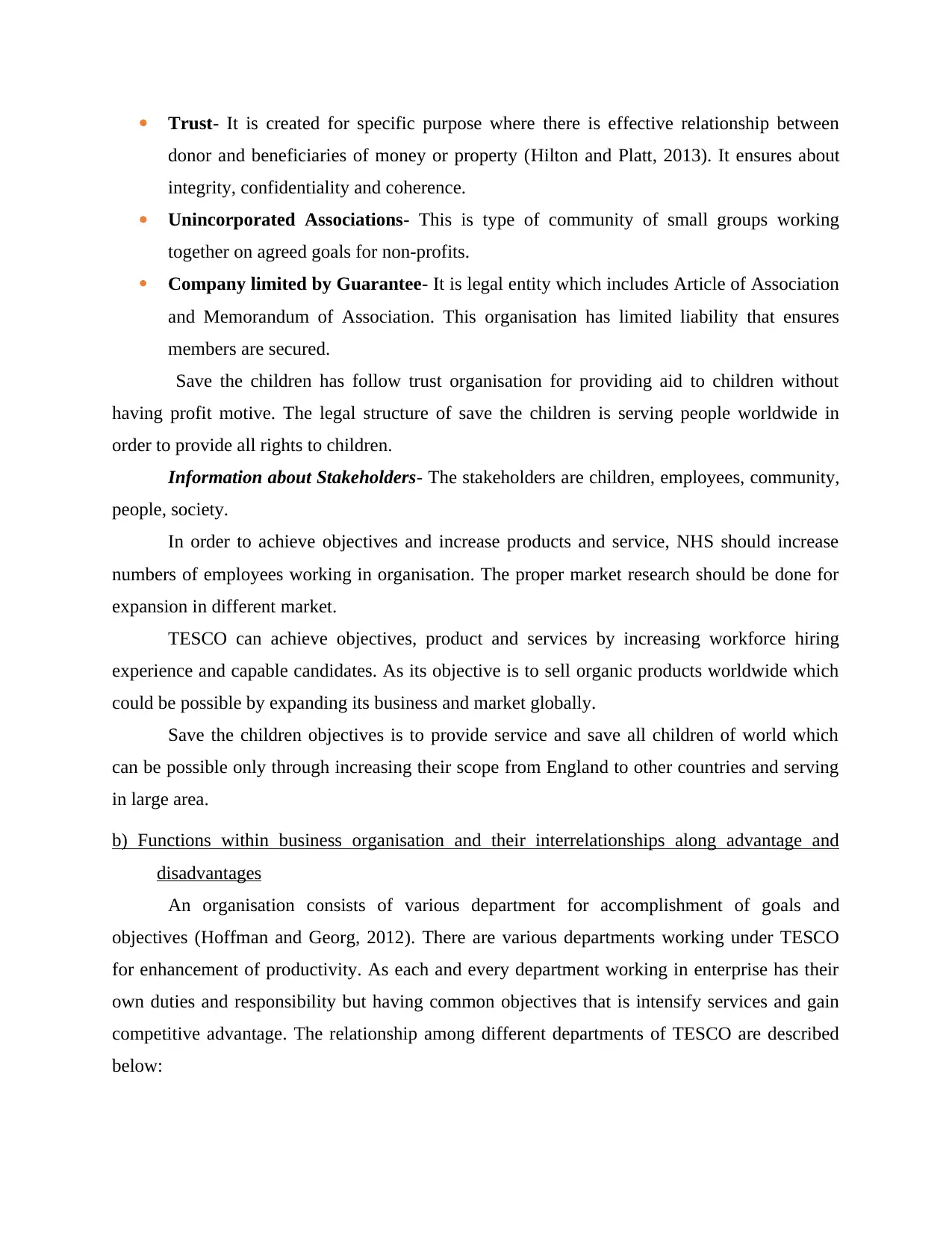
Trust- It is created for specific purpose where there is effective relationship between
donor and beneficiaries of money or property (Hilton and Platt, 2013). It ensures about
integrity, confidentiality and coherence.
Unincorporated Associations- This is type of community of small groups working
together on agreed goals for non-profits.
Company limited by Guarantee- It is legal entity which includes Article of Association
and Memorandum of Association. This organisation has limited liability that ensures
members are secured.
Save the children has follow trust organisation for providing aid to children without
having profit motive. The legal structure of save the children is serving people worldwide in
order to provide all rights to children.
Information about Stakeholders- The stakeholders are children, employees, community,
people, society.
In order to achieve objectives and increase products and service, NHS should increase
numbers of employees working in organisation. The proper market research should be done for
expansion in different market.
TESCO can achieve objectives, product and services by increasing workforce hiring
experience and capable candidates. As its objective is to sell organic products worldwide which
could be possible by expanding its business and market globally.
Save the children objectives is to provide service and save all children of world which
can be possible only through increasing their scope from England to other countries and serving
in large area.
b) Functions within business organisation and their interrelationships along advantage and
disadvantages
An organisation consists of various department for accomplishment of goals and
objectives (Hoffman and Georg, 2012). There are various departments working under TESCO
for enhancement of productivity. As each and every department working in enterprise has their
own duties and responsibility but having common objectives that is intensify services and gain
competitive advantage. The relationship among different departments of TESCO are described
below:
donor and beneficiaries of money or property (Hilton and Platt, 2013). It ensures about
integrity, confidentiality and coherence.
Unincorporated Associations- This is type of community of small groups working
together on agreed goals for non-profits.
Company limited by Guarantee- It is legal entity which includes Article of Association
and Memorandum of Association. This organisation has limited liability that ensures
members are secured.
Save the children has follow trust organisation for providing aid to children without
having profit motive. The legal structure of save the children is serving people worldwide in
order to provide all rights to children.
Information about Stakeholders- The stakeholders are children, employees, community,
people, society.
In order to achieve objectives and increase products and service, NHS should increase
numbers of employees working in organisation. The proper market research should be done for
expansion in different market.
TESCO can achieve objectives, product and services by increasing workforce hiring
experience and capable candidates. As its objective is to sell organic products worldwide which
could be possible by expanding its business and market globally.
Save the children objectives is to provide service and save all children of world which
can be possible only through increasing their scope from England to other countries and serving
in large area.
b) Functions within business organisation and their interrelationships along advantage and
disadvantages
An organisation consists of various department for accomplishment of goals and
objectives (Hoffman and Georg, 2012). There are various departments working under TESCO
for enhancement of productivity. As each and every department working in enterprise has their
own duties and responsibility but having common objectives that is intensify services and gain
competitive advantage. The relationship among different departments of TESCO are described
below:
Paraphrase This Document
Need a fresh take? Get an instant paraphrase of this document with our AI Paraphraser
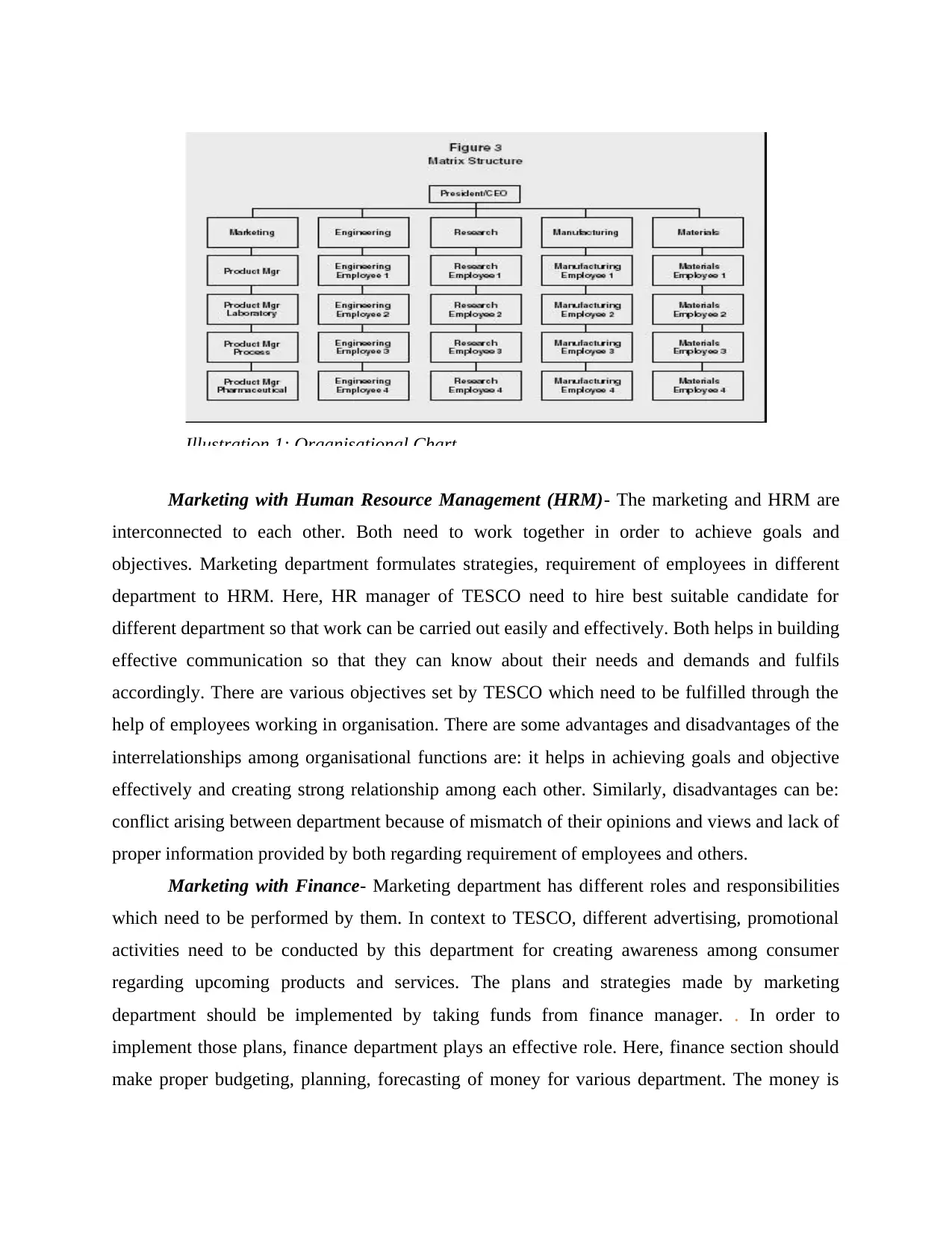
Marketing with Human Resource Management (HRM)- The marketing and HRM are
interconnected to each other. Both need to work together in order to achieve goals and
objectives. Marketing department formulates strategies, requirement of employees in different
department to HRM. Here, HR manager of TESCO need to hire best suitable candidate for
different department so that work can be carried out easily and effectively. Both helps in building
effective communication so that they can know about their needs and demands and fulfils
accordingly. There are various objectives set by TESCO which need to be fulfilled through the
help of employees working in organisation. There are some advantages and disadvantages of the
interrelationships among organisational functions are: it helps in achieving goals and objective
effectively and creating strong relationship among each other. Similarly, disadvantages can be:
conflict arising between department because of mismatch of their opinions and views and lack of
proper information provided by both regarding requirement of employees and others.
Marketing with Finance- Marketing department has different roles and responsibilities
which need to be performed by them. In context to TESCO, different advertising, promotional
activities need to be conducted by this department for creating awareness among consumer
regarding upcoming products and services. The plans and strategies made by marketing
department should be implemented by taking funds from finance manager. . In order to
implement those plans, finance department plays an effective role. Here, finance section should
make proper budgeting, planning, forecasting of money for various department. The money is
Illustration 1: Organisational Chart
interconnected to each other. Both need to work together in order to achieve goals and
objectives. Marketing department formulates strategies, requirement of employees in different
department to HRM. Here, HR manager of TESCO need to hire best suitable candidate for
different department so that work can be carried out easily and effectively. Both helps in building
effective communication so that they can know about their needs and demands and fulfils
accordingly. There are various objectives set by TESCO which need to be fulfilled through the
help of employees working in organisation. There are some advantages and disadvantages of the
interrelationships among organisational functions are: it helps in achieving goals and objective
effectively and creating strong relationship among each other. Similarly, disadvantages can be:
conflict arising between department because of mismatch of their opinions and views and lack of
proper information provided by both regarding requirement of employees and others.
Marketing with Finance- Marketing department has different roles and responsibilities
which need to be performed by them. In context to TESCO, different advertising, promotional
activities need to be conducted by this department for creating awareness among consumer
regarding upcoming products and services. The plans and strategies made by marketing
department should be implemented by taking funds from finance manager. . In order to
implement those plans, finance department plays an effective role. Here, finance section should
make proper budgeting, planning, forecasting of money for various department. The money is
Illustration 1: Organisational Chart
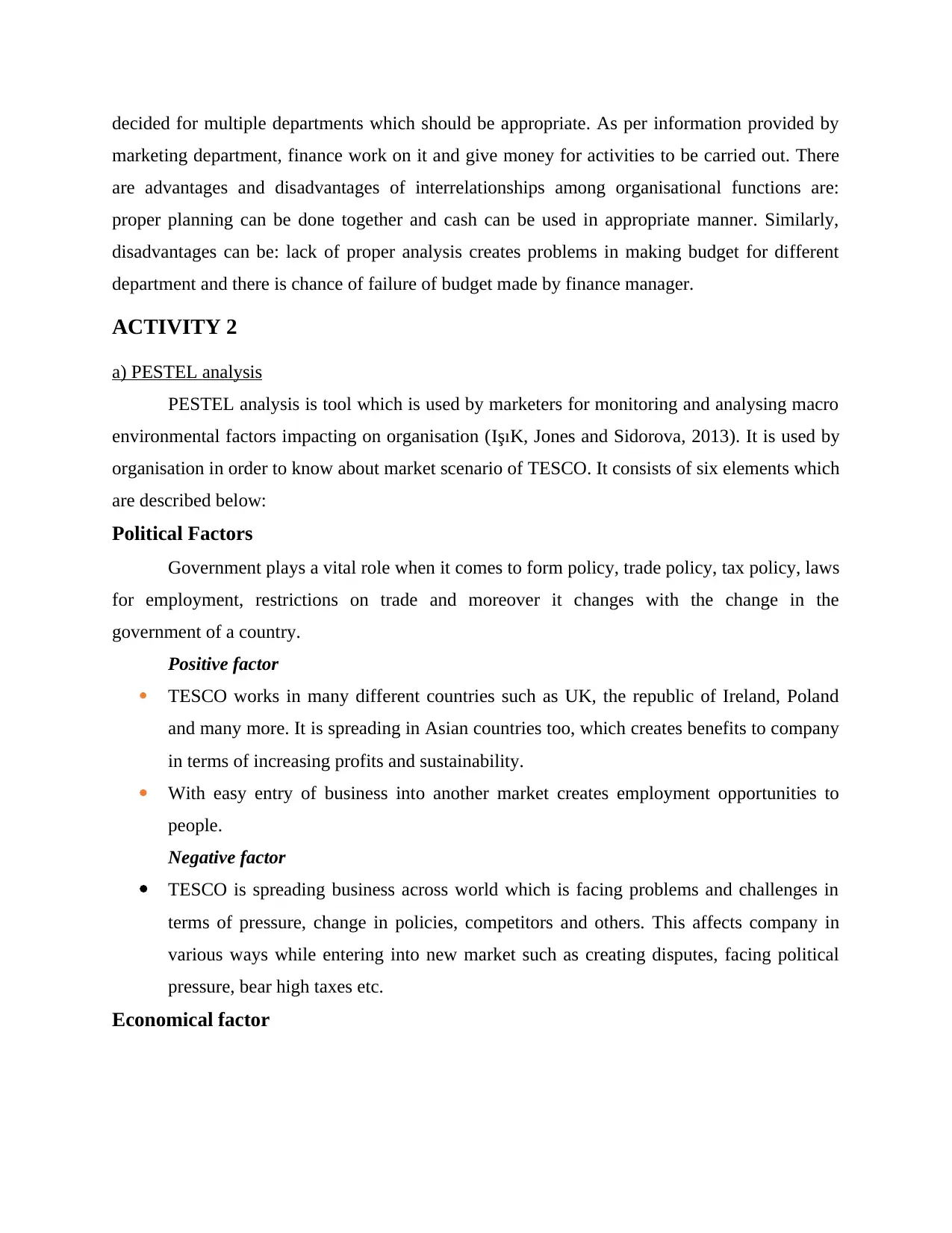
decided for multiple departments which should be appropriate. As per information provided by
marketing department, finance work on it and give money for activities to be carried out. There
are advantages and disadvantages of interrelationships among organisational functions are:
proper planning can be done together and cash can be used in appropriate manner. Similarly,
disadvantages can be: lack of proper analysis creates problems in making budget for different
department and there is chance of failure of budget made by finance manager.
ACTIVITY 2
a) PESTEL analysis
PESTEL analysis is tool which is used by marketers for monitoring and analysing macro
environmental factors impacting on organisation (IşıK, Jones and Sidorova, 2013). It is used by
organisation in order to know about market scenario of TESCO. It consists of six elements which
are described below:
Political Factors
Government plays a vital role when it comes to form policy, trade policy, tax policy, laws
for employment, restrictions on trade and moreover it changes with the change in the
government of a country.
Positive factor
TESCO works in many different countries such as UK, the republic of Ireland, Poland
and many more. It is spreading in Asian countries too, which creates benefits to company
in terms of increasing profits and sustainability.
With easy entry of business into another market creates employment opportunities to
people.
Negative factor
TESCO is spreading business across world which is facing problems and challenges in
terms of pressure, change in policies, competitors and others. This affects company in
various ways while entering into new market such as creating disputes, facing political
pressure, bear high taxes etc.
Economical factor
marketing department, finance work on it and give money for activities to be carried out. There
are advantages and disadvantages of interrelationships among organisational functions are:
proper planning can be done together and cash can be used in appropriate manner. Similarly,
disadvantages can be: lack of proper analysis creates problems in making budget for different
department and there is chance of failure of budget made by finance manager.
ACTIVITY 2
a) PESTEL analysis
PESTEL analysis is tool which is used by marketers for monitoring and analysing macro
environmental factors impacting on organisation (IşıK, Jones and Sidorova, 2013). It is used by
organisation in order to know about market scenario of TESCO. It consists of six elements which
are described below:
Political Factors
Government plays a vital role when it comes to form policy, trade policy, tax policy, laws
for employment, restrictions on trade and moreover it changes with the change in the
government of a country.
Positive factor
TESCO works in many different countries such as UK, the republic of Ireland, Poland
and many more. It is spreading in Asian countries too, which creates benefits to company
in terms of increasing profits and sustainability.
With easy entry of business into another market creates employment opportunities to
people.
Negative factor
TESCO is spreading business across world which is facing problems and challenges in
terms of pressure, change in policies, competitors and others. This affects company in
various ways while entering into new market such as creating disputes, facing political
pressure, bear high taxes etc.
Economical factor
⊘ This is a preview!⊘
Do you want full access?
Subscribe today to unlock all pages.

Trusted by 1+ million students worldwide
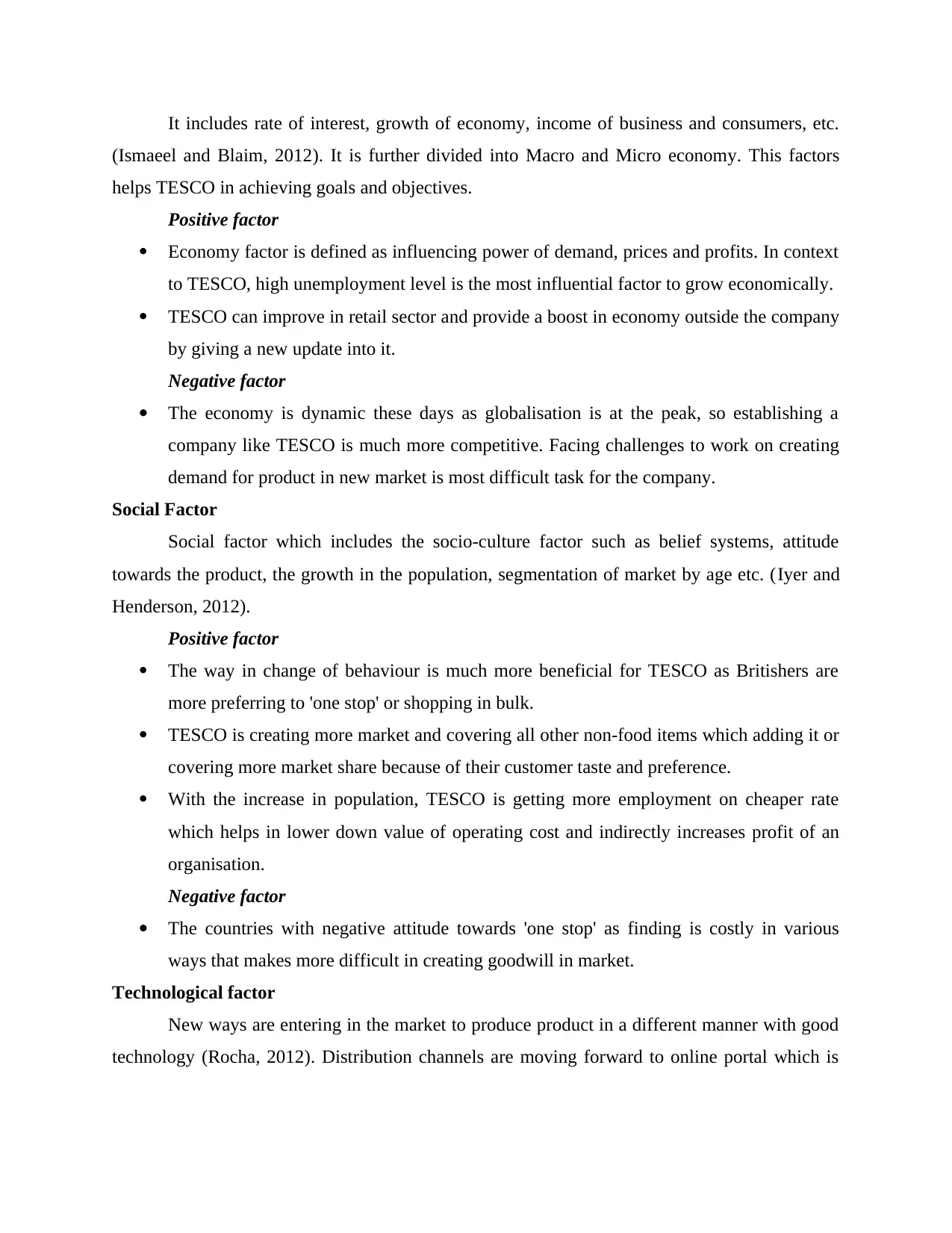
It includes rate of interest, growth of economy, income of business and consumers, etc.
(Ismaeel and Blaim, 2012). It is further divided into Macro and Micro economy. This factors
helps TESCO in achieving goals and objectives.
Positive factor
Economy factor is defined as influencing power of demand, prices and profits. In context
to TESCO, high unemployment level is the most influential factor to grow economically.
TESCO can improve in retail sector and provide a boost in economy outside the company
by giving a new update into it.
Negative factor
The economy is dynamic these days as globalisation is at the peak, so establishing a
company like TESCO is much more competitive. Facing challenges to work on creating
demand for product in new market is most difficult task for the company.
Social Factor
Social factor which includes the socio-culture factor such as belief systems, attitude
towards the product, the growth in the population, segmentation of market by age etc. (Iyer and
Henderson, 2012).
Positive factor
The way in change of behaviour is much more beneficial for TESCO as Britishers are
more preferring to 'one stop' or shopping in bulk.
TESCO is creating more market and covering all other non-food items which adding it or
covering more market share because of their customer taste and preference.
With the increase in population, TESCO is getting more employment on cheaper rate
which helps in lower down value of operating cost and indirectly increases profit of an
organisation.
Negative factor
The countries with negative attitude towards 'one stop' as finding is costly in various
ways that makes more difficult in creating goodwill in market.
Technological factor
New ways are entering in the market to produce product in a different manner with good
technology (Rocha, 2012). Distribution channels are moving forward to online portal which is
(Ismaeel and Blaim, 2012). It is further divided into Macro and Micro economy. This factors
helps TESCO in achieving goals and objectives.
Positive factor
Economy factor is defined as influencing power of demand, prices and profits. In context
to TESCO, high unemployment level is the most influential factor to grow economically.
TESCO can improve in retail sector and provide a boost in economy outside the company
by giving a new update into it.
Negative factor
The economy is dynamic these days as globalisation is at the peak, so establishing a
company like TESCO is much more competitive. Facing challenges to work on creating
demand for product in new market is most difficult task for the company.
Social Factor
Social factor which includes the socio-culture factor such as belief systems, attitude
towards the product, the growth in the population, segmentation of market by age etc. (Iyer and
Henderson, 2012).
Positive factor
The way in change of behaviour is much more beneficial for TESCO as Britishers are
more preferring to 'one stop' or shopping in bulk.
TESCO is creating more market and covering all other non-food items which adding it or
covering more market share because of their customer taste and preference.
With the increase in population, TESCO is getting more employment on cheaper rate
which helps in lower down value of operating cost and indirectly increases profit of an
organisation.
Negative factor
The countries with negative attitude towards 'one stop' as finding is costly in various
ways that makes more difficult in creating goodwill in market.
Technological factor
New ways are entering in the market to produce product in a different manner with good
technology (Rocha, 2012). Distribution channels are moving forward to online portal which is
Paraphrase This Document
Need a fresh take? Get an instant paraphrase of this document with our AI Paraphraser
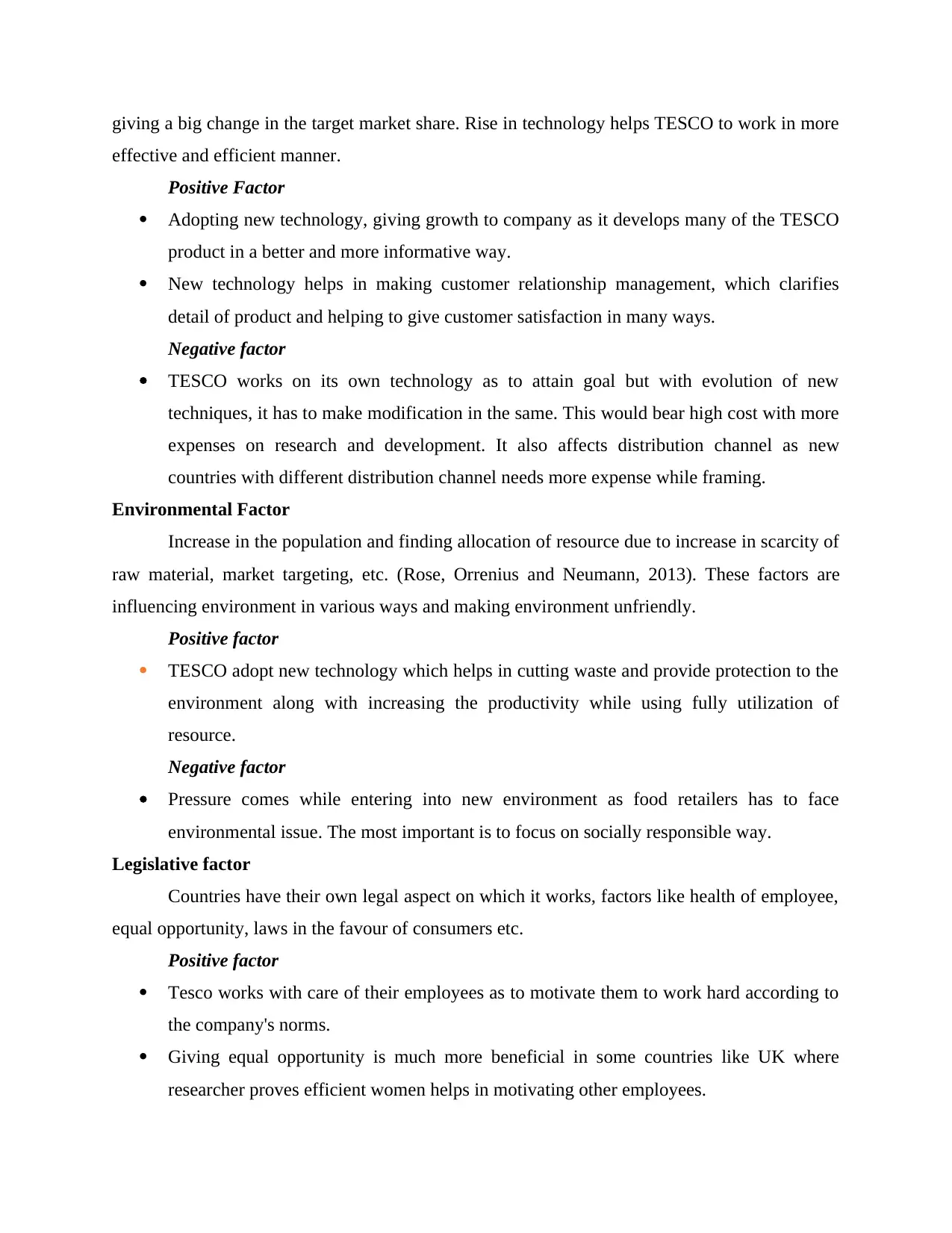
giving a big change in the target market share. Rise in technology helps TESCO to work in more
effective and efficient manner.
Positive Factor
Adopting new technology, giving growth to company as it develops many of the TESCO
product in a better and more informative way.
New technology helps in making customer relationship management, which clarifies
detail of product and helping to give customer satisfaction in many ways.
Negative factor
TESCO works on its own technology as to attain goal but with evolution of new
techniques, it has to make modification in the same. This would bear high cost with more
expenses on research and development. It also affects distribution channel as new
countries with different distribution channel needs more expense while framing.
Environmental Factor
Increase in the population and finding allocation of resource due to increase in scarcity of
raw material, market targeting, etc. (Rose, Orrenius and Neumann, 2013). These factors are
influencing environment in various ways and making environment unfriendly.
Positive factor
TESCO adopt new technology which helps in cutting waste and provide protection to the
environment along with increasing the productivity while using fully utilization of
resource.
Negative factor
Pressure comes while entering into new environment as food retailers has to face
environmental issue. The most important is to focus on socially responsible way.
Legislative factor
Countries have their own legal aspect on which it works, factors like health of employee,
equal opportunity, laws in the favour of consumers etc.
Positive factor
Tesco works with care of their employees as to motivate them to work hard according to
the company's norms.
Giving equal opportunity is much more beneficial in some countries like UK where
researcher proves efficient women helps in motivating other employees.
effective and efficient manner.
Positive Factor
Adopting new technology, giving growth to company as it develops many of the TESCO
product in a better and more informative way.
New technology helps in making customer relationship management, which clarifies
detail of product and helping to give customer satisfaction in many ways.
Negative factor
TESCO works on its own technology as to attain goal but with evolution of new
techniques, it has to make modification in the same. This would bear high cost with more
expenses on research and development. It also affects distribution channel as new
countries with different distribution channel needs more expense while framing.
Environmental Factor
Increase in the population and finding allocation of resource due to increase in scarcity of
raw material, market targeting, etc. (Rose, Orrenius and Neumann, 2013). These factors are
influencing environment in various ways and making environment unfriendly.
Positive factor
TESCO adopt new technology which helps in cutting waste and provide protection to the
environment along with increasing the productivity while using fully utilization of
resource.
Negative factor
Pressure comes while entering into new environment as food retailers has to face
environmental issue. The most important is to focus on socially responsible way.
Legislative factor
Countries have their own legal aspect on which it works, factors like health of employee,
equal opportunity, laws in the favour of consumers etc.
Positive factor
Tesco works with care of their employees as to motivate them to work hard according to
the company's norms.
Giving equal opportunity is much more beneficial in some countries like UK where
researcher proves efficient women helps in motivating other employees.
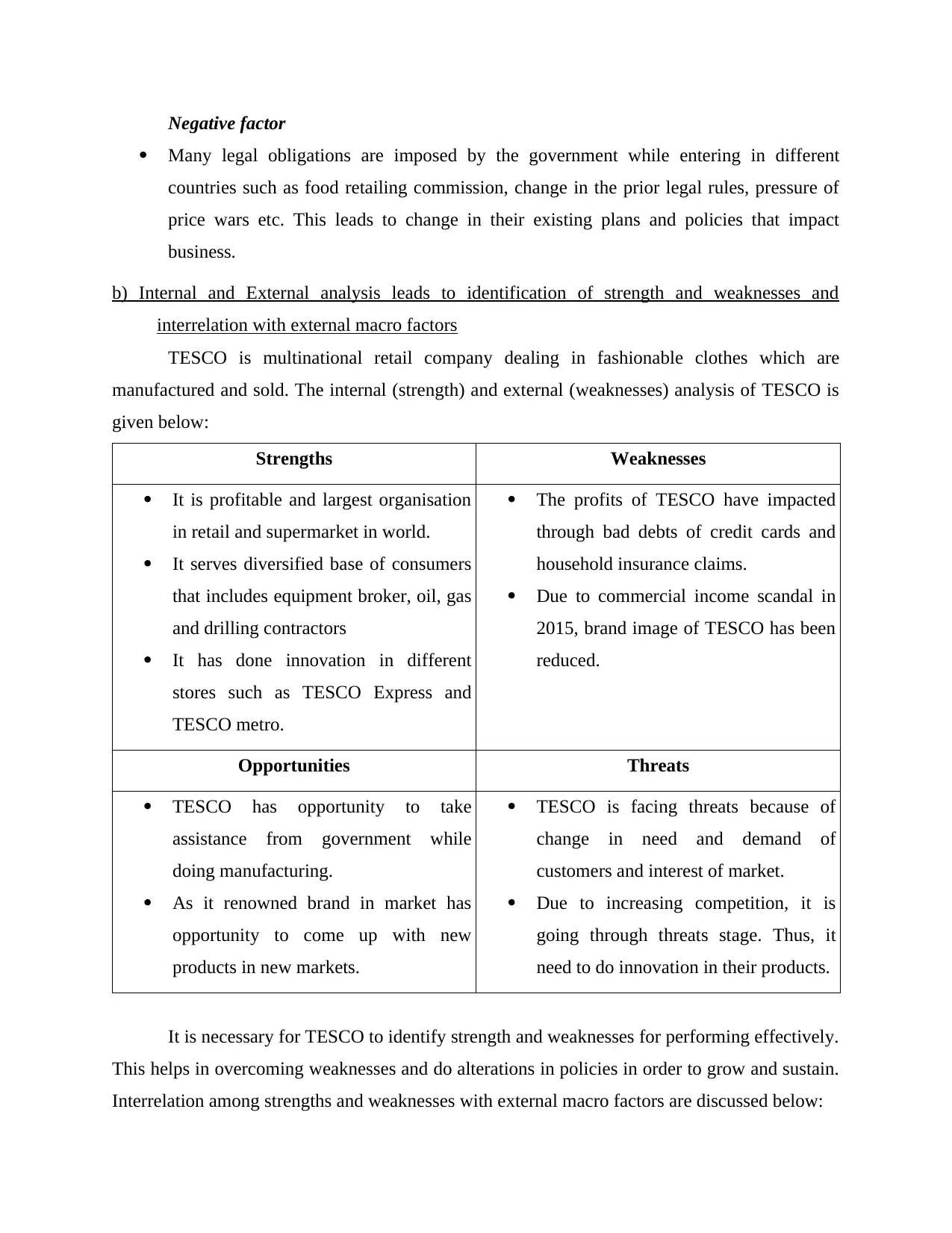
Negative factor
Many legal obligations are imposed by the government while entering in different
countries such as food retailing commission, change in the prior legal rules, pressure of
price wars etc. This leads to change in their existing plans and policies that impact
business.
b) Internal and External analysis leads to identification of strength and weaknesses and
interrelation with external macro factors
TESCO is multinational retail company dealing in fashionable clothes which are
manufactured and sold. The internal (strength) and external (weaknesses) analysis of TESCO is
given below:
Strengths Weaknesses
It is profitable and largest organisation
in retail and supermarket in world.
It serves diversified base of consumers
that includes equipment broker, oil, gas
and drilling contractors
It has done innovation in different
stores such as TESCO Express and
TESCO metro.
The profits of TESCO have impacted
through bad debts of credit cards and
household insurance claims.
Due to commercial income scandal in
2015, brand image of TESCO has been
reduced.
Opportunities Threats
TESCO has opportunity to take
assistance from government while
doing manufacturing.
As it renowned brand in market has
opportunity to come up with new
products in new markets.
TESCO is facing threats because of
change in need and demand of
customers and interest of market.
Due to increasing competition, it is
going through threats stage. Thus, it
need to do innovation in their products.
It is necessary for TESCO to identify strength and weaknesses for performing effectively.
This helps in overcoming weaknesses and do alterations in policies in order to grow and sustain.
Interrelation among strengths and weaknesses with external macro factors are discussed below:
Many legal obligations are imposed by the government while entering in different
countries such as food retailing commission, change in the prior legal rules, pressure of
price wars etc. This leads to change in their existing plans and policies that impact
business.
b) Internal and External analysis leads to identification of strength and weaknesses and
interrelation with external macro factors
TESCO is multinational retail company dealing in fashionable clothes which are
manufactured and sold. The internal (strength) and external (weaknesses) analysis of TESCO is
given below:
Strengths Weaknesses
It is profitable and largest organisation
in retail and supermarket in world.
It serves diversified base of consumers
that includes equipment broker, oil, gas
and drilling contractors
It has done innovation in different
stores such as TESCO Express and
TESCO metro.
The profits of TESCO have impacted
through bad debts of credit cards and
household insurance claims.
Due to commercial income scandal in
2015, brand image of TESCO has been
reduced.
Opportunities Threats
TESCO has opportunity to take
assistance from government while
doing manufacturing.
As it renowned brand in market has
opportunity to come up with new
products in new markets.
TESCO is facing threats because of
change in need and demand of
customers and interest of market.
Due to increasing competition, it is
going through threats stage. Thus, it
need to do innovation in their products.
It is necessary for TESCO to identify strength and weaknesses for performing effectively.
This helps in overcoming weaknesses and do alterations in policies in order to grow and sustain.
Interrelation among strengths and weaknesses with external macro factors are discussed below:
⊘ This is a preview!⊘
Do you want full access?
Subscribe today to unlock all pages.

Trusted by 1+ million students worldwide
1 out of 17
Related Documents
Your All-in-One AI-Powered Toolkit for Academic Success.
+13062052269
info@desklib.com
Available 24*7 on WhatsApp / Email
![[object Object]](/_next/static/media/star-bottom.7253800d.svg)
Unlock your academic potential
Copyright © 2020–2025 A2Z Services. All Rights Reserved. Developed and managed by ZUCOL.





